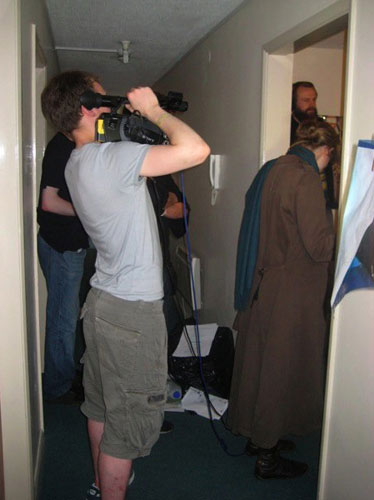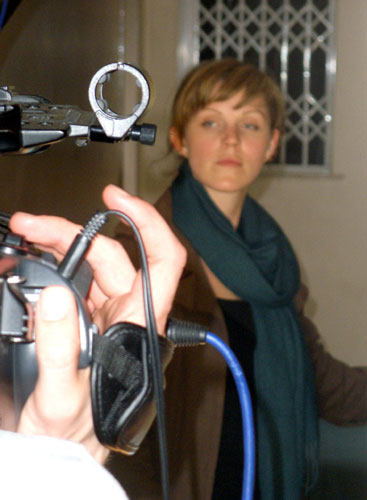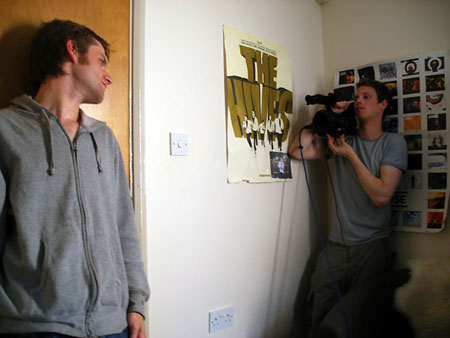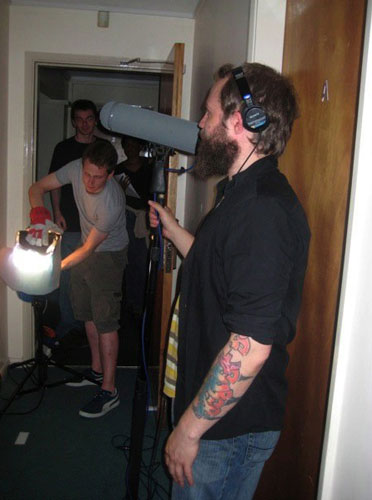The crew and actors give their thoughts on Threshold:
Andrew Parkhill MA Screenwriting
Threshold was suggested by the announcement of a Flu Buddy system, whereby anyone who suspected they had swine flu would nominate someone to collect medicine for them, so they could stay at home and avoid infecting anybody else – except, presumably, the hapless Buddy.
From this there followed the image of two people on opposite sides of a door: maybe friends, partners, neighbours, near-strangers, but driven apart by paranoia and the risk of infection.
That motif was the hook. But once the script was considered for production, I had to start trying to answer all the backstory questions I’d been avoiding: who exactly were Will and Karen? What was their history? And, flu aside, what’s really at stake in their current relationship?
To me, the initial scenario had suggested a kind of farce. But notes from Matt, the director, Dan, course leader and other MA students guided it in a darker, more intense direction, where we might possibly be able to take these characters seriously.
Rewrites continued during auditions, which helped indicate what worked in the script and what didn’t. Lines that seemed fine on the page stuck out badly when read aloud, or broke the back-and forth rhythm of the building argument.
I find silences can be more dramatic than speech, so my favourite moments tended to be characters’ private reactions to whatever they’re hearing through the door. Likewise, the more confrontational dialogue, where Will and Karen really speak their minds, gave the actors more shouting, but arguably less substance to work with. Editing naturally favours the actor who’s speaking, but watching the final edit, there were moments when I thought it would potentially be more revealing to show the listener than the speaker.
Overall, the adaptation exercise showed how a starting-off point need be no more than that – an assignment focused on swine flu became a story where the virus itself mattered far less than establishing the past and current relationship of its characters. And there were the inevitable moments where an actor came up with a manner or alternative way of delivering a line that was better than what I had in mind. Damn them.
It also taught me how vital it is for a writer to know their characters. Even if they never leave the room (and in Will’s case there certainly wasn’t much chance of that), we need to believe in their life beyond that scene. Which was just one reason why it was so good to have a talented group of filmmakers, co-writers and actors asking all those difficult questions.

Producing under difficult shooting conditions, photo by Kathryn A Wilson
Kathryn Wilson: Producer
Producing Threshold was challenging for two reasons. Firstly, it was an exercise in filmmaking for the MA Screenwriting students. This meant that some of the collaborators did not have any experience of short film production. Secondly, the project had a very short pre-production phase.
I was particularly drawn to the script because it was a simple story that was easy to capture in one day of filming. But the story takes place in a larger, almost post-apocalyptic world. I knew that this could be easily created through basic production design involving particular symbols (i.e. the chemical warning symbol) and creative post-production sound.
In order to prepare the MA students for the production Dan (the tutor), Matt (the director) and I gave the students a crash-course in short filmmaking. Once everyone understood what the different crew roles involve, people volunteered themselves for different tasks. As a producer, the task of delegating responsibility was quite challenging on this project. I constantly had to weigh up the benefits of immersing the students in the learning process (and thus potentially slowing the production down) and attempting to get the film made and to a reasonable standard. So for example, we decided to bring in some students from the BA production course in order to fulfil some of the more technical roles such as DOP, Sound Recordist and Editor.
In pre-production I contributed to intensive script development sessions. Alongside this I began to bring in actors for casting sessions. I learned a lot about casting on this project. Many of the MA students would sit in on the casting sessions and it was very helpful that the writer especially was involved in this as it aided his script development work. Time restraints meant that the casting period was short and by the end of the first week I was beginning to worry because we hadn’t found any actors who were suitable for the roles. It was necessary to find two people who we felt were compatible on screen, as they had to convey the sensitivities of a relationship.
At this point I learned a key lesson – casting is one area where you should push to the very last minute to try and find the right people. We kept looking and eventually found Aurora and Richard who I feel were very well suited to the roles. The mantra that one should keep looking, even when you are beginning to despair – as opposed to settling for second best, is something that I have applied to producing work ever since.
The next challenge was to find the right location. From the outset it was decided that the film would be shot over one day only. It was therefore essential to find a single location that could provide our two main requirements – those of a corridor and a flat. We looked at a few different locations and eventually chose a flat which a friend of one of our crew members lived in. The corridor was just wide enough for us to film in. I made sure to have a back up location in case something went wrong (another mantra – always have a back-up plan!). When working with locations I find that the relationship with the owner is very important. I knew from the outset that the owners were willing to be helpful and accommodating and this was a large factor in my choice.
The production day was quickly approaching. I took the production designer on a recce to the property so that she could plan how to dress the space. Matt set to work on the story-board and shot list. I translated this into a shooting schedule for the day. The small budget that we had for the project was spent mainly on food for the day. Learning how to feed a crew decent meals without spending a fortune, is an important skill for a low budget short film producer! I made sure that everything was in place for the filming day and that everyone had call sheets (describing what would happen on the day) and movement orders (informing people how to get to the location).
The location was cramped so we had to manage the space well to prevent over-crowding. We had the windows shut and blocked out to keep out the natural light, so the place got very stuffy. I tried to make sure that everyone had plenty of drinks on hand throughout the day. I oversaw the work of the 1st AD (as it was the first time they had done the job) to make sure that the filming was running to schedule. I made sure that the actors were being looked after and that all were happy and things were running smoothly. We stayed on schedule throughout the day. Matt, our director, is used to working in a professional environment. His attitude helped us keep to schedule. Things sped up towards the end of the day when we were trying to get the last shots finished.
Once the shoot was done I over-saw the post-production phase. This is another point in filmmaking that requires stamina. Once the production phase is over there is often a lull in enthusiasm for the project. A producer must make sure that a film is delivered as a finished product. The film is, in many ways, re-written in the edit. We made sure that different versions of the film were screened to people regularly so that we could gather feedback. Eventually sound was added and the images were colour-corrected. We had our first screening of the finished product with the group and the film was received very well.
Although I initially saw this project more as an ‘exercise’ than an attempt to make a decent film, I think the project grew to become a nice little film in its own right. I feel this success firstly with the script, which was fantastic and well suited to the scope of the project. Secondly, all involved pitched in to bring as much value as they could to their own areas, which I feel really shows on screen. Student films are rarely perfect, but the film succeeds in many ways. The project was a great learning curve for all involved.
http://www.humanfilm.co.uk/the-team
Matt Maude – Director
From a directing point of view the pre-production period of the film was relatively carefree for me. I'd spent some time with Andrew tweaking the script to make it more ‘shootable’. By this I mean to start with I felt there wasn’t enough drama in the script and the dialogue felt like it was for something bigger, almost like a play. So I tried as much as possible to make it more believable, honest, relationship-like.
Other than that I was working on another project during this time so much of the actual organising work was left to the producer, Kathryn Wilson, who did an incredible job. As the exercise was constructed to highlight every process of the production, the students worked closely with Kathryn to cast the actors, find the location and facilitate the shoot (AD-ing, location managing, production co-ordinating). I'm used to preparing everything before I shoot (storyboards, rehearsing the actors, collaborating with heads of department) but this was the first time I've ever just turned up and shot something unrehearsed. It was a very organic thing, collaborating with the crew and actors, working out shots in the moment. It was an awesome experience for me, and a huge confidence booster for directing spontaneously.
My previous work has been in directing in music videos, a genre whereby the director both writes and directs the concept. Having never worked on a script written by someone other than myself the opportunity of working on an 'unknown' script was a great and rewarding challenge. Having the chance to adapt Andrew's script was an experience in itself as often I'm entirely inflexible when working off my own scripts. It's really taught me to be less stubborn with my own work, willing to compromise and be more open to seeing/creating something in the moment.
It's also made me realise that you should never direct anything where there's more than one writer present! Having a class of eight writers on set was like climbing Everest with no legs.

Shot at close range, photo by Andrew Parkhill
Aurora Fearnley, Actress playing Karen
I have worked with a few of the Northern Film School filmmakers before and have always been impressed by the high level of content they produce. As an actor it's healthy to meet the up and coming directors and producers of tomorrow as well as the experience you can gain from a short film project.
The audition was only 20 mins and the scene was rehearsed with one of the script writers. Together we ran through the scene from different emotional points of view, with the team being most satisfied with a bitchy character. The producer Kathryn gave notes and recorded the audition on a camera to show the director at a later date.
For this short film it was the script that excited me and the amount of conflict within the character. Karen has to battle her selfish instinct to survive and not become infected while still caring for her partner who is dying and her medicine his only chance to life. It's not often that I get the chance to move through the range of emotions so quickly, which is a fantastic challenge for an actor. A short with panic and a life or death decision gives the audience a reason to keep watching.
Matt Maude was an exceptionally good director, with enthusiasm and obvious talent. I learned to trust his suggestions quickly on set and my acting improved as a result. He had a real skill for obtaining a very natural performance and keeping too much ‘drama’ out of the scene, which was important as the dialogue could have been easily overplayed. Working closely with the other actor Richard was very easy and relaxed, we were going to be separated by a door for 90% of our scene together, so it felt important to build a relationship before the filming began. Matt had us rehearse alone with him and gave suggestions to our read through, giving more intimacy to the lines and working on our back story.
The day was planned with a series of shot lists and unusually for a short film we worked in chronological order throughout the script. One of the most important factors for a filming day is an equal balance of strict rules and fun attitude, this production was a lot of fun for me and the entire crew were welcoming.
In terms of character and costume I decided to dress myself and bring wardrobe. The look I tried to encapsulate was in homage to films like Terminator Salvation, strong boots, big flapping jackets all in army fatigue colours. It gives the impression of underground resistance in a world turning bad. Hopefully this will have subtly entered the audiences mind and placed the small contained flat in a wilderness city on the brink of human annihilation. But hey, that is entirely my interpretation of the script and setting.
or
http://www.littlenorthernlight.com

Behind the door, photo by Andrew Parkhill
William Lewis – DOP
I came to the Threshold project very late on, when I was asked to fill in for the Director of Photography who had become too ill to do the shoot. I only had two days to read the script, decide how I thought it should be shot, make up the equipment list and visit the location. However, it was a good script, which helped me build up a vivid mental image of the film and make decisions quickly.
All credit to Matt, the director, who knew exactly what he wanted. We both instinctively leaned towards a frenetic, documentary camera style evocative of films like 28 Days Later and [Rec] and high contrast lighting, making full use of light and dark. I had the idea of balancing the camera to daylight so that the picture appears cold and devoid of hope – a simple way to transform what was student accommodation into the nightmarish world of the film. The whole team worked terrifically well together; the communication and discipline were both very good, and I got a strong sense that everybody really cared about the project. This was especially impressive given that much of the crew was made up of screenwriters who had limited experience of the production side of the filmmaking process, making it a wholly rewarding and pleasurable day of filming.
Ian Pinder – Sound and Editing
I had no involvement in pre-production at all on the project. I only became involved just before production as Location Sound Recordist. It was difficult for Kathryn Wilson (Producer) to find anybody to commit to the project in this role. I remember the single day's shooting being quite a good experience. Matt Maude (Director) and the actors were professional and respectful to the role, which is not always the case.
We tried hard to keep the production dialogue clear of extraneous sounds and we did a number of room-tone (background ambience for locations) and wild-track recordings (door-slams, lines of dialogue that were missed, keys jangling . . .) to assist the editorial team on the film. The decision had been taken to record all audio to the video camera being used on the shoot (I believe, on my advice in this situation) in order that manual syncing of all the footage would not be necessary.
Once the shoot was complete, I had presumed my part in the production was over but I was asked to fill the vacant role of picture editor. Matt and I began the process of the assembly edit and Matt was quite open to my input on the whole, and I was relatively pleased with our working relationship. I am keen on the Director and Editor being a team when it comes to post-production, and a degree of trust was built up quite quickly. There were editorial choices that were a benefit to the film, which were carried through, even though they changed the original script at times. This willingness to change was quite professional and very welcome.
Watching the completed film I became aware of some 'crossing the line' issues with the editing around the scene with both characters talking with the door open. I think this issue may have been raised at the time, but cannot recall any discussion of it. I can only assume that we came to the conclusion that the issue did not become a problem without repeated viewings.

Sound and light, photo by Kathryn A Wilson
Towards the end of the project, I drifted into the role of Sound Editor. I was left some degree of control over what to do with the soundtrack, under some direction from Matt, and at times Dan and Kathryn. Due mainly to time being quite limited, there was no extravagant work done on the soundtrack. For aesthetic and practical reasons, music was not used which I think was the right choice for the film. I used a mixture of sounds that I recorded specifically for the project, and sounds like dog-barks and outside ambiences that I had recorded previously. We managed to succeed in creating the muted dialogue through the door between the characters relatively well.
I spent some time working on the look of the titles, which were the second version that I showed to Matt. The first ones did not clearly define character and actor names on first glances. I chose to use Futura Bold as a typeface, and I seem to remember Matt having separately thought of the same font for the titles. I remember speaking to some extent about the directors Stanley Kubrick and Wes Anderson, and their love of the font for film titles. Much of this part of the process was quite smooth, and it was quite rare for Matt and I, or anybody else to have much disagreement on these matters.
Once the film had gone through a number of screenings with tutors and crew, the edit was finalised. I remember being happy with quite a lot of the film, and thought that the editing choices had improved parts of the script that were not quite developed originally.
I feel that a lot of what I learned from my involvement in the project was to do with what I want to accomplish in my career in filmmaking. I think that after this project, I came to the conclusion that I wanted to focus on directing, and have editing and sound design as more background endeavours. I have followed through on this to some extent in my BA 3rd year at the film school, and have plans to do more of the same in the near future.
Lydia Rain, MA Screenwriting student
This was the first film I'd worked on, so to me everything was simultaneously normal and strange. I was involved in the film in the script development stage, casting and as Production Designer.
Working as a team on script development was a conundrum: one person was responsible for writing, the other five threw ideas about, freely criticised and then went home to wait for the writer to work out how to preserve his original vision while making sweeping changes overnight. Casting was like having live dolls to act out your game – blowing the script out of 2D into flesh and blood, adding further interpretations of the story – where to put the emphasis in a line, for example. Difficult not having a clear sense of whose decisions counted, whether I should speak out or not – I put that down to me being new.
I loved doing the production design: in my next life, that's what I'll do, create worlds. It was great to feel I had some creative input. Being a lifelong scavenger and pauper, the choke-tight budget was a minor challenge, but the real arse ache was time – in the end, it beat me, and some scenes just didn't look as good as I wanted.
Being on set during shooting was like being kidnapped by Trappists and put into sensory deprivation – but a doss compared to those directly involved in the action. It made me realise how little I want to direct, film, act or produce – and yet I would have liked more control. It was all a glorious compromise, a miscegenation of vying ideas and priorities, producing a mongrel byblow that was better than it would have been if all those people hadn't interfered.